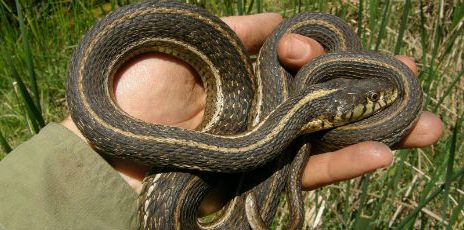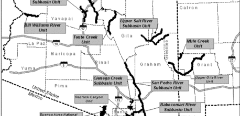External links for Northern Mexican Gartersnake
Northern Mexican Gartersnake
Thamnophis eques megalops

Identification
Northern Mexican gartersnakes can be difficult to distinguish from other striped gartersnakes. This species has a black, brown, olive, tan, or rust background color with creamy yellow mid-dorsal (center of the back) and side stripes (Brennan and Holycross 2006, Rossman et al. 1996b). The critical defining feature is that the side stripes are found on the 3rd and 4th scale rows (counting from the belly scales) near the anterior (front) of the body; in other gartersnakes these stripes are found on the 2nd or 3rd scale rows (refer to AZGFD gartersnake identification cards or Brennan and Holycross 2006). This species may have paired dark neck blotches. The head in large adults is often noticeably broad compared to other gartersnakes. Black lines outline the scales on the lower face. Interrupted black lines may also outline the mid-dorsal stripe, and create the appearance of black and white or greenish dashes on the back between the stripes (Brennan and Holycross 2006). Younger snakes often have lighter-colored backgrounds; these darken as the snakes age, so that large adults may appear to have a nearly black background color. Adult female northern Mexican gartersnakes can reach 44 inches in total length (1,120 mm; Brennan and Holycross 2006).
Similar species include the black-necked gartersnake and the striped morph of the wandering gartersnake. These species may be differentiated by the position of the side stripes; in wandering and black-necked gartersnakes these stripes are on the 2nd and 3rd scale rows. Wandering gartersnakes may have obvious square-edged blotches in addition to stripes. Wandering gartersnakes typically do not have very broad heads, nor are their face scales so clearly outlined by black borders. Black-necked gartersnakes typically have very obvious paired black neck patches and grey on the top of the head. On black-necked gartersnakes, the mid-dorsal stripe is strongly yellow or orange on the anterior part of the body, while the side stripes are often white, resulting in a very brightly contrasting overall appearance.

Status & distribution
The northern Mexican gartersnake (Thamnophis eques megalops) is a federally threatened wetland and riparian-obligate snake (USFWS 2014). Critical habitat for this sensitive species has been proposed but not yet finalized (USFWS 2013). This species is protected under Arizona Game and Fish Department Commission Order 43 (Reptiles): no collection, harassment or harming, hunting, trapping, or capture is allowed without special permits (Arizona Game and Fish Department 2011a).
Northern Mexican gartersnakes are in the Southwestern United States and in the Sierra Madre Occidental and the Mexican Plateau of Mexico (Rossman et al. 1996b); In the United States, the species is found primarily in Arizona, with scattered populations historically present in southwestern New Mexico (Degenhardt et al. 1996, Brennan and Holycross 2006). Populations occur at lower elevations than narrow-headed gartersnakes (131-6151 feet [40-1875 m] elevation) in rivers, marshes, lake impoundments, stock tanks, and fish hatcheries (Brennan and Holycross 2006, Cotten et al. 2013; USFWS 2014; Sullivan et al. 2016; Emmons and Nowak 2016; J. Myrand unpubl.).
Ecology
The brumation period for northern Mexican gartersnakes in previous and current radiotelemetry studies generally began between early November and mid-December, and ended between late February and early March (Boyarski et al. 2015; Emmons and Nowak 2016; J. Myrand unpubl.; T. Sprague unpubl.). Unlike narrow-headed gartersnakes, telemetered and non-telemetered northern Mexican gartersnakes were observed active at or outside of hibernation sites during the winter, but did not appear near foraging ponds until mid- to late March. Brumation sites were located 0-160m from water’s edge in diverse habitats including rocky slopes (including fill areas), rock and flood debris piles, mesquite bosque, meadows, riparian woodland, trash dumping grounds, and burrows along aquatic edges (Boyarski et al. 2015; Emmons and Nowak 2016; J. Myrand unpubl.; T. Sprague unpubl.).
After emerging from hibernation in late February or March, telemetered northern Mexican gartersnakes were active in grassy or weedy meadows several hundred meters from fallow and active fish-rearing ponds, and were first seen foraging in the ponds in early to mid-April (Boyarski et al. 2015). The snakes made the largest movements in March and April as they were moving from brumation sites to foraging areas. During this period Boyarski et al. (2015) made many visual observations, especially in the mornings, as the snakes were surface active and basking frequently. During the rest of the active season, telemetered individuals rarely moved more than 50-100 m from water’s edge, yet were rarely seen because they were often in burrows or under dense vegetative cover surrounding the ponds. At Bubbling Ponds Fish Hatchery and the upper-middle Verde River, females that were likely gestating in late May and early June often remained underground until parturition and used more sun-exposed habitats including meadows, floodplains, and clearings (Boyarski et al. 2015; Emmons and Nowak 2016; T. Sprague unpubl.). Females appeared to move to fallow ponds, backwaters and aquatic edges with rushes, cattails and tules associated with shallow water to give birth, and young of the year snakes were primarily found in proximity to these habitat features. Apart from the birthing season, adults were often found foraging in ponds with deeper (several meters) water and less vegetative cover.
Females give birth from 7 to 38 young in June through early July (Rosen and Schwalbe 1988, Nowak and Boyarski 2012; Emmons and Nowak 2016). The birthing season may coincide with the emergence of toad metamorphs or even certain invertebrates (USFWS 2014). Breeding may occur in spring (i.e., Rosen and Schwalbe 1988); more data is needed to determine if breeding also occurs in the fall, as it does in some other snake species.
Primary prey items are amphibians and fish (García and Drummond 1988, Rosen and Schwalbe 1988, Holycross et al. 2006; USFWS 2014, Boyarski et al. 2015, Emmons et al. 2016a); juveniles may also eat earthworms and leeches (Macías-García and Drummond 1988). Amphibians include all age classes of toads (Anaxyrus spp.), native Ranid frogs and non-native American Bullfrogs (L. catesbeiana), spadefoot toads (Spea spp., d’Orgeix et al. 2013); and larval tiger salamanders (Ambystoma spp.). Fish include natives (e.g. Gila topminnow Poeciliopsis occidentalis occidentalis, desert pupfish Cyprinodon macularius, Gila chub and roundtail chub Gila. spp), and non-natives (e.g. mosquitofish Gambusia affinis, largemouth bass Micropterus salmoides, black bullhead Ameiurus melas, possibly green sunfish Lepomis cyanellus and bluegill L. macrochirus) (Emmons et al. 2016a). Young and Boyarski (2012) also documented northern Mexican gartersnakes feeding on non-native Chinese mystery snails (Cipangopaludina chinensis) at Bubbling Ponds Fish Hatchery.
Threats
As with narrow-headed gartersnakes, northern Mexican gartersnakes have suffered extensive population declines throughout their ranges in the United States (Holycross et al. 2006, Hibbitts et al. 2009, USFWS 2014). Surveys in Arizona and New Mexico indicate that many declines have occurred within the last two decades (Rosen and Schwalbe 1988, Holycross et al. 2006, USFWS 2014).
Threats include introduced non-native predators (e.g. nonnative predatory fish, bullfrogs Lithobates catesbeianus, and crayfish Orconectes virilis) (Young and Boyarski 2012), native predators including red-tailed hawks (Buteo jamaicensis) (Emmons et al. 2016b), disappearance of native fish and amphibian prey, and loss or degradation of habitat (Rosen and Schwalbe 1988, 2002; Nowak and Santana-Bendix 2002; Holycross et al. 2006; Hibbitts et al. 2009, USFWS 2014). Factors such as disease, siltation (resulting in loss of foraging habitat), human predation, and overgrazing are also suspected or hypothesized as reasons for decline in some areas (USFWS 2014). Recent apparent range expansions in native predator populations, such as otters (Lontra canadensis, Nowak, unpubl. data) and common black hawks (Buteogallus anthracinus, Etzel 2010), may also have impacts on populations of gartersnakes that are already reduced by other factors; however these potential effects have not been studied. As with narrow-headed gartersnakes, it is likely that no one factor has resulted in declines, but rather combinations of factors may act synergistically to cause declines.